

Narcissus tazetta 'Italicus'
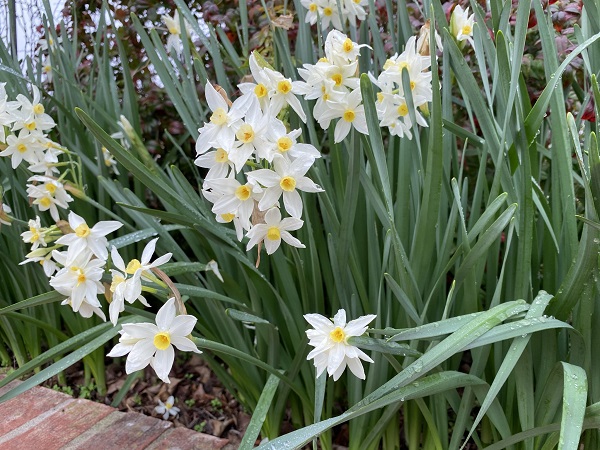
If you live in more northern parts of the South and long for some sort of paperwhite, then the Italicus is your answer. The most notable aspect of the flowers is their star-shaped petals appearing on the numerous flowers emerging from a single bulb. Narcissus tazetta 'Italicus' is similar to the Chinese sacred lily, but the 'Italicus' has a lemon-yellow cup as opposed to the Chinese sacred lily's solid gold. The 'Italicus' has a fragrance that is slightly sweet. You can expect solid multiplication and continued blooms for this generation and the next.
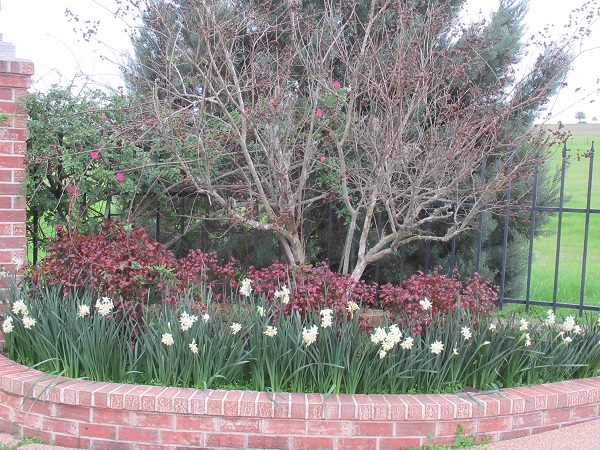
It can be hard sometimes for me to stay focused in January. Although there are bulbs blooming in the field, as I drive around I don't see the massive displays of color that I see later in the spring. That is, I don't see large displays of color, until my eye is struck with a cemetery filled with creamy white, highly fragrant blooms. I take out my camera and capture the scene, and my eye once again is reminded to never, ever stop looking for pretty bulbs in the many different, often forgotten places of the world. These truly do extend the seasons of color in your personal garden, giving you that splash right after the first of the year.
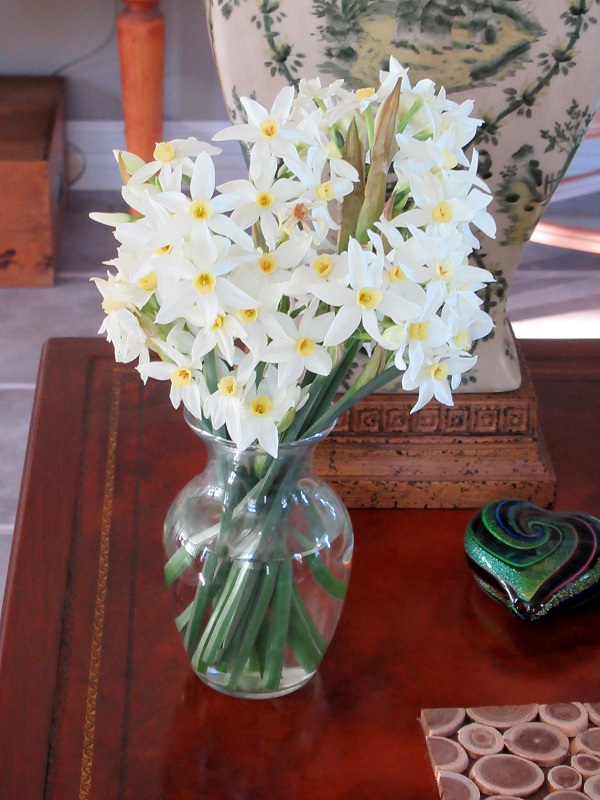
We usually take time here to tell you some great ways to landscape the bulb we are featuring. We have an entire article about that if you want to click on the link Narcissus and Daffodils that will take you to our website's page and then scroll to the bottom where you can read about landscaping, daffodils, narcissus, where to plant, and several more topics.
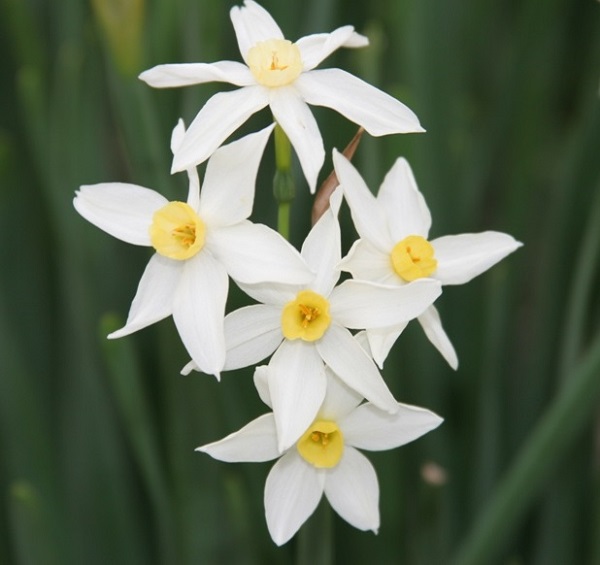
UNIQUE: The 'Italicus' are unique among the narcissus with their blooms being one of the very first to appear in the new year in late January or February. The petals on this narcissus bloom don't overlap which allows you to truly enjoy its slightly off-white star shape. This narcissus bulb is one of the largest that we have, along with the Grand Primo. This reliable January bloomer is found in old Spanish and French settlements across Louisiana and does well in our Zone 8 each year near Tyler, TX.
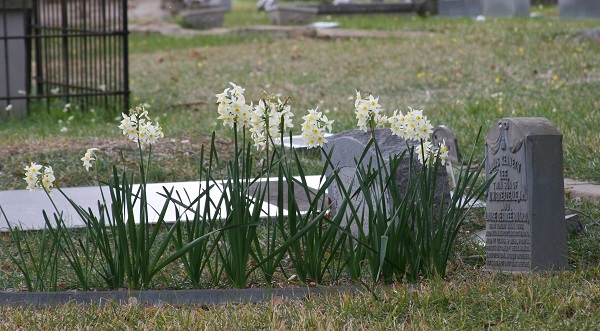
TAZETTA: So you may notice that this one is called a Narcssisus tazetta. What makes a tazetta bulb different from a non-tazetta bulb? Great question! Tazetta flowers have smaller cups, but a LOT more of them. The outer petals can be white, yellow, or orange and the inner cup can be white, yellow, or orange, and there can be many combinations in between. Tazettas are generally larger and more robust than the smaller species flower bulbs often referred to as narcissus. The "tazetta" group is valued because most bulbs in this category are great perennials, and a gardener can choose selections that bloom in December, January, February, and March!
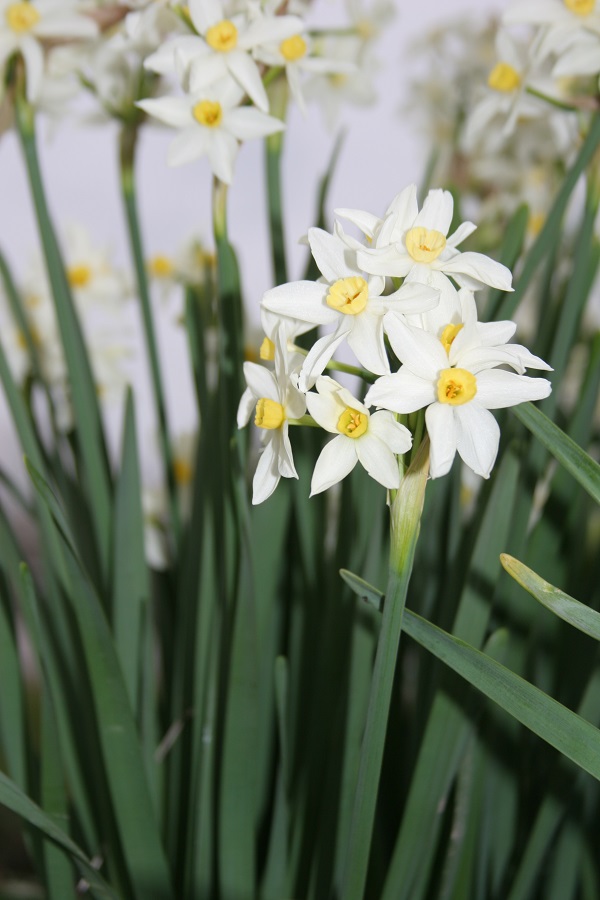
DO I PLANT OR DO I WAIT? We know that it is hot in the summer! It is almost too hot for us to be outside for very long. Even though it is so hot and will likely get hotter in many places with August just around the corner, the narcissus bulbs don't care. They are dormant right now anyway, and it doesn't matter if they sit in the ground or on your counter. They aren't going to grow until spring. The most important thing to remember is to plant them where they will have at least 1/2 day of winter sun. Many people only want to plant the narcissus in the fall. That's ok. Others want to plant their bulbs as soon as they get them. That's ok. If it's too hot to plant them right now or you want to wait, just take them out of the sack that they come in and keep them out of direct sunlight until you are ready to put them in the ground.
In the summer and fall, we ship dry bulbs that many consumers are familiar with. However, in the spring we ship some flower bulbs with their foliage still on them, having dug them right after their bloom. When the customer receives them, the foliage is in the process of drying down naturally. Plant the bulbs, with foliage and all in the ground and let the foliage turn brown and die back naturally. Another option is to not plant the flower bulbs and store the bulbs with the foliage in a cool, dark, and well ventilated spot, and most importantly let the foliage die down naturally. In other words, DON'T cut the foliage of bulbs when you receive them in the green. The browning and dying back of the foliage is the natural process of the bulb sending food and energy from the leaves down into the bulbs for their summer dormancy.
I thought daffodil bulbs are normally shipped in the fall? We grow many of our own daffodils here on our farm, and while it is unconventional in the United States, it is common to have bulbs shipped in the green in other parts of the world. We grow many of our own heirloom daffodils that we originally collected from old gardens on former homesites. Shipping these in the green allows us to:
1) Ship them during the bloom season when most gardeners are thinking of and remembering to plant daffodils
2) Ensures correct identification of the flower bulb. These are heirlooms and buying and receiving the right genetic selections is important to having varieties that are perennials and will naturalize in your garden
3) Allows us to offer more bulbs are lower prices to customers
Remember that bulbs shipped in the green are coming to an end of their growth cycle. You can expect:
1) The foliage to yellow and die down naturally
2) The bulb to be dormant in the summer and early fall
3) Roots to start growing in mid fall
4) Foliage appears next January
5) Bulbs to bloom next January and February
Narcissus tazetta 'Italicus'

If you live in more northern parts of the South and long for some sort of paperwhite, then the Italicus is your answer. The most notable aspect of the flowers is their star-shaped petals appearing on the numerous flowers emerging from a single bulb. Narcissus tazetta 'Italicus' is similar to the Chinese sacred lily, but the 'Italicus' has a lemon-yellow cup as opposed to the Chinese sacred lily's solid gold. The 'Italicus' has a fragrance that is slightly sweet. You can expect solid multiplication and continued blooms for this generation and the next.

It can be hard sometimes for me to stay focused in January. Although there are bulbs blooming in the field, as I drive around I don't see the massive displays of color that I see later in the spring. That is, I don't see large displays of color, until my eye is struck with a cemetery filled with creamy white, highly fragrant blooms. I take out my camera and capture the scene, and my eye once again is reminded to never, ever stop looking for pretty bulbs in the many different, often forgotten places of the world. These truly do extend the seasons of color in your personal garden, giving you that splash right after the first of the year.

We usually take time here to tell you some great ways to landscape the bulb we are featuring. We have an entire article about that if you want to click on the link Narcissus and Daffodils that will take you to our website's page and then scroll to the bottom where you can read about landscaping, daffodils, narcissus, where to plant, and several more topics.

UNIQUE: The 'Italicus' are unique among the narcissus with their blooms being one of the very first to appear in the new year in late January or February. The petals on this narcissus bloom don't overlap which allows you to truly enjoy its slightly off-white star shape. This narcissus bulb is one of the largest that we have, along with the Grand Primo. This reliable January bloomer is found in old Spanish and French settlements across Louisiana and does well in our Zone 8 each year near Tyler, TX.

TAZETTA: So you may notice that this one is called a Narcssisus tazetta. What makes a tazetta bulb different from a non-tazetta bulb? Great question! Tazetta flowers have smaller cups, but a LOT more of them. The outer petals can be white, yellow, or orange and the inner cup can be white, yellow, or orange, and there can be many combinations in between. Tazettas are generally larger and more robust than the smaller species flower bulbs often referred to as narcissus. The "tazetta" group is valued because most bulbs in this category are great perennials, and a gardener can choose selections that bloom in December, January, February, and March!

DO I PLANT OR DO I WAIT? We know that it is hot in the summer! It is almost too hot for us to be outside for very long. Even though it is so hot and will likely get hotter in many places with August just around the corner, the narcissus bulbs don't care. They are dormant right now anyway, and it doesn't matter if they sit in the ground or on your counter. They aren't going to grow until spring. The most important thing to remember is to plant them where they will have at least 1/2 day of winter sun. Many people only want to plant the narcissus in the fall. That's ok. Others want to plant their bulbs as soon as they get them. That's ok. If it's too hot to plant them right now or you want to wait, just take them out of the sack that they come in and keep them out of direct sunlight until you are ready to put them in the ground.
In the summer and fall, we ship dry bulbs that many consumers are familiar with. However, in the spring we ship some flower bulbs with their foliage still on them, having dug them right after their bloom. When the customer receives them, the foliage is in the process of drying down naturally. Plant the bulbs, with foliage and all in the ground and let the foliage turn brown and die back naturally. Another option is to not plant the flower bulbs and store the bulbs with the foliage in a cool, dark, and well ventilated spot, and most importantly let the foliage die down naturally. In other words, DON'T cut the foliage of bulbs when you receive them in the green. The browning and dying back of the foliage is the natural process of the bulb sending food and energy from the leaves down into the bulbs for their summer dormancy.
I thought daffodil bulbs are normally shipped in the fall? We grow many of our own daffodils here on our farm, and while it is unconventional in the United States, it is common to have bulbs shipped in the green in other parts of the world. We grow many of our own heirloom daffodils that we originally collected from old gardens on former homesites. Shipping these in the green allows us to:
1) Ship them during the bloom season when most gardeners are thinking of and remembering to plant daffodils
2) Ensures correct identification of the flower bulb. These are heirlooms and buying and receiving the right genetic selections is important to having varieties that are perennials and will naturalize in your garden
3) Allows us to offer more bulbs are lower prices to customers
Remember that bulbs shipped in the green are coming to an end of their growth cycle. You can expect:
1) The foliage to yellow and die down naturally
2) The bulb to be dormant in the summer and early fall
3) Roots to start growing in mid fall
4) Foliage appears next January
5) Bulbs to bloom next January and February